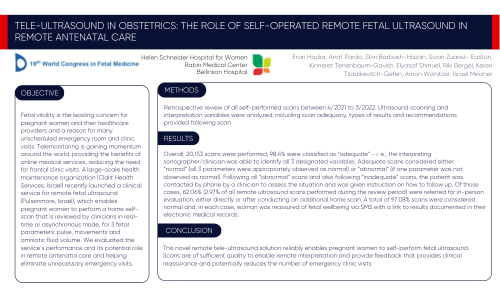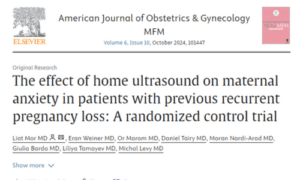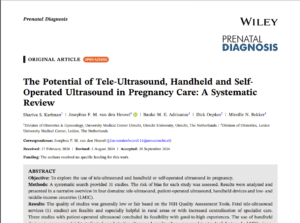Authors: Eran Hadar, Anat Pardo, Shiri Barbash-Hazan, Sivan Zuarez- Easton, Kinneret Tenenbaum-Gavish, Elyasaf Shmuel, Riki Bergel, Keren Tzadikevitch-Gefen, Arnon Wiznitzer, Israel Meizner
Objective:
Fetal vitality is the leading concern for pregnant women and their healthcare providers and a reason for many unscheduled emergency room and clinic visits. Telemonitoring is gaining momentum around the world, providing the benefits of online medical services, reducing the need for frontal clinic visits. A large-scale health maintenance organization (Clalit Health Services, Israel) recently launched a clinical service for remote fetal ultrasound (Pulsenmore, Israel), which enables pregnant women to perform a home self- scan that is reviewed by clinicians in real- time or asynchronous mode, for 3 fetal parameters: pulse, movements and amniotic fluid volume. We evaluated the service’s performance and its potential role in remote antenatal care and helping eliminate unnecessary emergency visits.
Methods:
Retrospective review of all self-performed scans between 4/2021 to 3/2022. Ultrasound scanning and interpretation variables were analyzed, including scan adequacy, types of results and recommendations provided following scan
Results:
Overall, 20,153 scans were performed, 98.4% were classified as “adequate” – i. e., the interpreting sonographer/clinician was able to identify all 3 designated variables. Adequate scans considered either “normal” (all 3 parameters were appropriately observed as normal) or “abnormal” (if one parameter was not observed as normal). Following all “abnormal” scans and also following “inadequate” scans, the patient was contacted by phone by a clinician to assess the situation and was given instruction on how to follow up. Of those cases, 62.06% (2.97% of all remote ultrasound scans performed during the review period) were referred for in-person evaluation, either directly or after conducting an additional home scan. A total of 97.08% scans were considered normal and, in each case, woman was reassured of fetal wellbeing via SMS with a link to results documented in their electronic medical records.
Conclusions:
This novel remote tele-ultrasound solution reliably enables pregnant women to self-perform fetal ultrasound. Scans are of sufficient quality to enable remote interpretation and provide feedback that provides clinical reassurance and potentially reduces the number of emergency clinic visits

Presented at: FMF 19th World congress of Fetal Medicine in Greece, 2022






